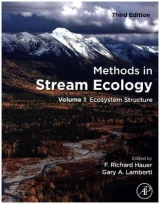
Methods in Stream Ecology
Academic Press Inc (Verlag)
978-0-12-332908-0 (ISBN)
- Titel erscheint in neuer Auflage
- Artikel merken
Methods in Stream Ecology, Second Edition, provides a complete series of field and laboratory protocols in stream ecology that are ideal for teaching or conducting research.
This updated edition reflects recent advances in the technology associated with ecological assessment of streams, including remote sensing. In addition, the relationship between stream flow and alluviation has been added, and a new chapter on riparian zones is also included.
The book features exercises in each chapter; detailed instructions, illustrations, formulae, and data sheets for in-field research for students; and taxanomic keys to common stream invertebrates and algae.
With a student-friendly price, this book is key for all students and researchers in stream and freshwater ecology, freshwater biology, marine ecology, and river ecology. This text is also supportive as a supplementary text for courses in watershed ecology/science, hydrology, fluvial geomorphology, and landscape ecology.
F. Richard (Ric) Hauer, is Director of the University of Montana’s Center for Integrated Research on the Environment (CIRE) and Professor of Stream Ecology at the Flathead Lake Biological Station where he taught Stream Ecology for >25 years. His major research interests encompass the broad, interdisciplinary field of ecosystem ecology with focus on freshwaters, especially running waters and gravel-bed river floodplains and wetlands. The breadth of his research spans from physical processes of sediment transport and groundwater/surface water interactions to aquatic insect life histories and ecosystem assessment. He is particularly interested in the application of remotely sensed data to understanding biophysical processes of floodplain ecology. To this end, he pilots his own airplane in the acquisition of digital imagery used to evaluate the landscape scale linkages between hydrology, geomorphology and ecology in river and floodplain ecosystems. Dr. Hauer has conducted his research around the eastern Pacific-rim from Alaska to Patagonia; his primary research site being the transboundary Crown-of-the-Continent Ecosystem and the Flathead River of Montana and British Columbia. While it was the fascination with aquatic invertebrates, especially caddisflies, that captured his interest, it has been his love for streams and rivers as disproportionately important components of biodiversity of mountain landscapes that has maintained that passion. Dr. Hauer has published >100 research articles in international peer-reviewed journals such as Science, Science Advances, BioScience and Freshwater Science. In addition to his personal research, he has served at the national level in developing environmental policy and implementation of environmental assessment in the Clean Water Act working with both the US Army Corps of Engineers and the US EPA. Ric is past-President of the international scientific society “Society for Freshwater Science. At the University of Montana, Hauer held the Stream Ecology Endowed Chair at Flathead Lake Biological Station from 2000-2016 and received the university’s Distinguished Scholar Award in 2011. He is founding director of the university’s interdisciplinary sciences graduate program, Systems Ecology. Dr. Gary A. Lamberti is Professor of Biological Sciences and Director of the Stream and Wetland Ecology Laboratory (SWEL) at the University of Notre Dame, where he teaches Biostatistics, Stream Ecology, Restoration Ecology, and a variety of topical graduate courses. His major research interests include (1) food web ecology of streams and wetlands, ranging from microbes to fish; (2) the ecology of native and introduced Pacific salmon; and (3) the impacts of climate change, toxins, and invasive species on aquatic ecosystem function. He retains a fundamental love for aquatic invertebrates, which permeates all of his research. He has also successfully advised 27 M.S. and Ph.D. students to completion and countless undergraduates have conducted research in his laboratory. Dr. Lamberti has over 175 publications dealing with various aspects of aquatic ecology, and has co-edited the Elsevier book entitled Methods in Stream Ecology, now in its 3rd edition. At Notre Dame, he also directs the GLOBES Graduate Certificate Program in Environment and Society. Dr. Lamberti is a Fellow of the American Association for the Advancement of Science and past-President of the Society for Freshwater Science, an international society of aquatic ecologists.
Section A: Physical Processes 1. Landscapes And Catchment Basins 2. Valley Segments, Stream Reaches, And Channel Units 3. Discharge Measurements And Streamflow Analysis 4. Dynamics Of Flow 5. Temperature, Light, And Oxygen 6. Hyporheic Zones
Section B: Material Storage And Transport 7. Fluvial Geomorphic Processes 8. Solute Dynamics 9. Phosphorus Limitation, Uptake, And Turnover In Stream Algae 10. Nitrogen Dynamics 11. Dissolved Organic Carbon 12. Transport And Storage Of Fpom 13. Cpom And Large Wood
Section C: Stream Biota 14. Heterotrophic Mirobes 15. Fungi: Biomass, Production And Sporulation Of Aquatic Hyphomycetes 16. Benthic Algae: Distribution And Structure 17. Biomass And Pigments Of Benthic Algae 18. Macrophytes And Bryophytes 19. Meiofauna 20. Macroinvertebrates 21. Macroinvertebrate Movements: Drift, Colonization, And Emergence 22. Fish Community Composition
Section D: Community Interactions 23. Plant - Herbivore Interactions 24. Predator-Prey Interactions 25. Trophic Relations Of Macroinvertebrates 26. Trophic Relations Of Stream Fishes 27. Stream Food Webs
Section E: Ecosystem Processes 28. Primary Productivity And Community Respiration 29. Secondary Production Of Macroinvertebrates 30. Decomposition In Stream Ecosystems 31. Riparian Processes And Interactions 32. Effects Of Nutrient Enrichment On Periphyton 33. Surface-Subsurface Interactions In Streams
Section F: Ecosystem Quality 34. Algae As Biotic Indicators Of Environmental Quality 35. Macroinvertebrates As Biotic Indicators Of Environmental Quality 36. Pollution And Toxicological Assessment
| Erscheint lt. Verlag | 25.7.2007 |
|---|---|
| Verlagsort | San Diego |
| Sprache | englisch |
| Maße | 184 x 260 mm |
| Gewicht | 2120 g |
| Themenwelt | Naturwissenschaften ► Biologie ► Ökologie / Naturschutz |
| Naturwissenschaften ► Physik / Astronomie | |
| ISBN-10 | 0-12-332908-6 / 0123329086 |
| ISBN-13 | 978-0-12-332908-0 / 9780123329080 |
| Zustand | Neuware |
| Haben Sie eine Frage zum Produkt? |
aus dem Bereich



